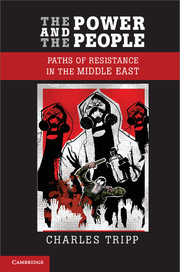Book contents
- Frontmatter
- Contents
- List of Illustrations and Credits
- Acknowledgements
- Glossary
- List of Abbreviations
- Introduction
- 1 State Capture and Violent Resistance
- 2 Contesting Public Space
- 3 Imposition and Resistance in Economic Life
- 4 Body Politics
- 5 History Wars
- 6 Symbolic Forms of Resistance
- Conclusion
- Notes
- Bibliography and Further Reading
- Index
6 - Symbolic Forms of Resistance
Art and Power
Published online by Cambridge University Press: 05 January 2013
- Frontmatter
- Contents
- List of Illustrations and Credits
- Acknowledgements
- Glossary
- List of Abbreviations
- Introduction
- 1 State Capture and Violent Resistance
- 2 Contesting Public Space
- 3 Imposition and Resistance in Economic Life
- 4 Body Politics
- 5 History Wars
- 6 Symbolic Forms of Resistance
- Conclusion
- Notes
- Bibliography and Further Reading
- Index
Summary
ART SPEAKS TO POWER
In the summer of 2002, in the middle of the Palestinian uprising known as intifadat al-aqsa, the Palestinian artist Vera Tamari set up an art installation in a field at al-Bireh near Ramallah. She organized a line of cars, nose to tail on a curved tarmac road laid down especially for the purpose. The striking feature was that the cars were crushed and flattened. Tamari had had them dragged there from the streets of al-Bireh and Ramallah where they had been squashed by Israeli tanks during one of the Israeli army’s military operations in April of that year. Ironically entitled ‘Mashin?’ [‘Going for a ride?’], the crushed cars, some with radios still playing and adorned with the usual mirror charms that had so obviously failed to protect them, stood as strange and haunting, but also eye-catching, reminders of everyday violence in occupied Palestine. In the words of Vera Tamari, the cars had taken on a new reality: ‘They metamorphosed from once practical objects to become subjects of vengeful voodooism. Do we hurt the Palestinians more by destroying their cherished personal belongings? . . . I simply wanted to make a statement how a mundane logical reality becomes totally illogical through the violence of the war machine . . . This act of destruction became like action art, disturbing the status quo of matter’. Someone could wake up one morning to find that tanks had rolled down their street and over their car. But at the same time, in the layout of the exhibition in a sunny field and with jaunty music playing over the radios, the installation itself asserted something about those subject to this violence. Self-consciously, by transforming the cars into an artwork, it signalled their refusal to be intimidated by Israeli military power. Tamari had shown her public defiance of the occupation, and had done so in a way that struck a chord with the many Palestinians who passed by or wandered around among the wrecked cars.
- Type
- Chapter
- Information
- The Power and the PeoplePaths of Resistance in the Middle East, pp. 256 - 308Publisher: Cambridge University PressPrint publication year: 2013



